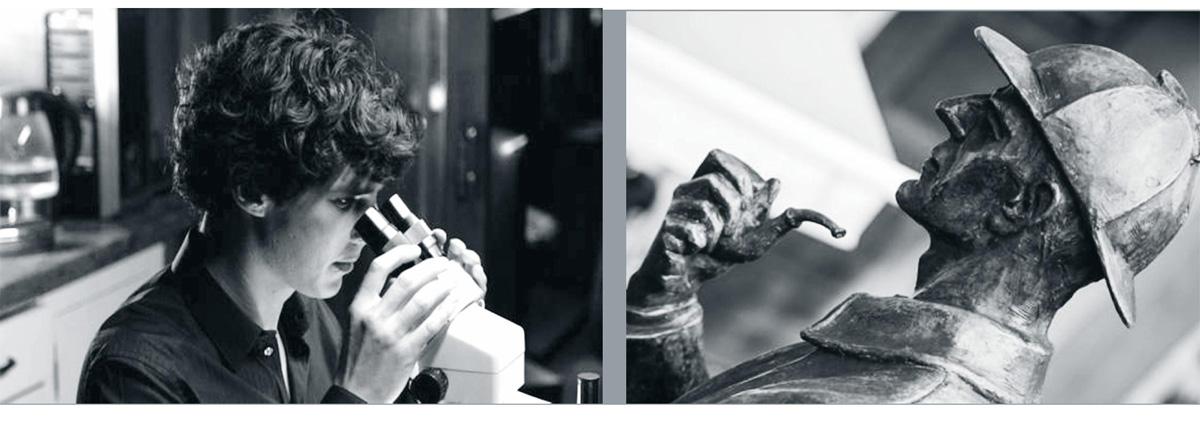福尔摩斯的演绎思维
2016-05-14世钦
世钦


What Sherlock Holmes Taught Us About the Mind
福尔摩斯系列小说是人们闲暇时极好的消遣读物,但如今它们竟然出现在医学教授列给学生的专业书单中。这究竟是怎么回事呢?相信大家都曾被这位小说中杜撰的天才侦探在破案时所展现出来的细致观察力和严密的逻辑推理力所折服,是的,这便是医学院的学生们要学习的内容。医院就如犯罪现场,我们需要精密的头脑和理性思维来为病人诊断。
1. embark on: 开始(工作),从事。
2. fusty: 传统的,老式的;anatomical: 解剖的,(人体或动物体)结构上的;volume: 书籍;The Complete Sherlock Holmes:《福尔摩斯探案全集》。
3. 一个虚构的侦探究竟能教给一位胸怀大志的神经学家什么呢?on earth: 究竟;aspiring: 有志气的,有抱负的;neurologist: 神经学家。
4. 无论你的专业是什么,书中的深刻见解都能为我们的理性思维艺术提供很好的指导。 expertise: 专门知识,专业技能;insight: 深刻见解;rational: 理性的。
5. 利斯指出,福尔摩斯的创造者阿瑟·柯南·道尔本身就是个内科医生,有证据表明他以当时一位出色的医生——爱丁堡皇家医院的约瑟夫·贝尔为原型塑造了福尔摩斯这个人物。Arthur Conan Doyle: 阿瑟·柯南·道尔(1859—1930),生于苏格兰爱丁堡,因塑造福尔摩斯而成为侦探小说历史上最重要的作家之一,堪称侦探悬疑小说的鼻祖;physician: 内科医生;infirmary: 医务室,医院。
6. try ones hand at: 一试身手。
7. 但利斯怀疑随着故事的不断展开,柯南·道尔可能也从其他医生身上汲取了灵感,比如威廉·高尔斯,他的作品被称为是“神经学的圣经”。
8. specialise in: 专门研究;neurodegenerative: 神经组织退化的,神经变性的;doctoral: 博士的; mutual: 共同的;Rudyard Kipling: 拉迪亚德·吉卜林,英国小说家,诗人。
9. diagnosis: 诊断;clinical demonstration: 临床示范;silver: 指Russell-Silver syndrome,一种罕见的先天疾病,主要特征为身材矮小,且通常在身体二侧呈现左右不对称;syphilis: 梅毒。
10. 作为医生,应该养成且永远保持一个习惯,就是在病人走进房间时就开始观察,注意他的外观和步态。acquire: 获得,学到;omit: 遗漏,疏忽;aspect: 面貌,神态;gait: 步态,步法。
11. 如果你能够做到这一点,那么你应该早就能看出他走路一瘸一拐。另外你现在肯定也看出他面色异常了,而事实上,你应该早就能注意到这一点。lame: 瘸的;tint: 色彩,色调。
12. remarkably: 非常地;profile: 描……的轮廓,扼要描述;scant: 不足的,缺乏的。
13. inconsequential: 不重要的,无足轻重的。
14.“我一直以来都秉承见微知著的信念,”柯南·道尔在《身份案》中写道。axiom: 原理, 格言;infinitely: 无限地,极其。
15. preconception: 事先形成的观点或思想; fog: v. 使迷惑,使困惑。
16. unprejudiced: 没有偏见的,公正的;order of the day: 日常的事,惯例。
17. chastise: 严惩,谴责;“The Scandal of Bohemia”:《波西米亚丑闻》,福尔摩斯系列中一则短篇小说。
18. 当你面对一个全然不熟悉的病例时,那就暂时忘掉脑海中所有的病症类型和名字。
19. sui generis:(拉丁语)独特的,特殊的;as such: 就其本身而论。
20. rival: 与……匹敌,比得上。
21. disturbance:(精神或身体的)失常; hysteria: 癔病,歇斯底里。
22. 我看完床头卡又查看了他的牙龈,发现了画家这个职业给他造成的影响——牙龈上有一条明显的铅线,就像床头卡上记录他职业的文字一样清晰可见。gum: 牙龈; conspicuous: 明显的,显而易见的; lead-line: 铅线,为铅中毒特征性体征。
23. infer: 推断,推理;pigment: 颜料,色料。
24. 类似的例子还有很多:这两个人都善于“反向推理”,比如逐一剖析导致某种疾病(对于高尔斯来说)或某宗谋杀案(对于福尔摩斯来说)的所有可能性。dissect: 剖析,仔细分析。
25. 福尔摩斯的一句名言很好地总结了这种方法:“排除了所有的不可能,剩下的即使再不可能,那也是事实的真相。”aphorism: 格言,警句;eliminate: 排除;improbable: 不大可能的。
26. confess: 承认,忏悔;mole: 飞蛾。
27. humility: 谦逊;curse: 诅咒; afflict: 使受痛苦,折磨。
28. 最近几年,伦敦大学学院的认知神经学家依迪尔·道尔记录了很多医学和法学“专家”由于偏见而影响了判断的案例——有的甚至是生死攸关。cognitive: 认知的,认识的; document: v. 记录;apparent: 表面上的,貌似真实的;forensic: 法庭的,法医的;bias: 偏见;life or death: 事关生死的,生命攸关的。
29. deduction: 推断。
30. fine: 优秀的,杰出的;mystery: 谜题。
Soon after Andrew Lees embarked on1 his medical career at University College Hospital London, one of his superiors gave him a rather strange reading list. Rather than the usual fusty anatomical volumes, it included The Complete Sherlock Holmes.2
What on earth could the fictional detective teach an aspiring neurologist?3 As it turns out, a good deal, as Lees recently wrote in a paper in Brain journal. Whatever your expertise, the insights provide a welcome lesson in the art of rational thinking.4
As Lees points out, Holmes creator Arthur Conan Doyle was a physician himself, and there is evidence that he modelled the character of Holmes on one of the leading doctors of the day, Joseph Bell of the Royal Edinburgh Infirmary.5 “I thought I would try my hand at6 writing a story where the hero would treat crime as Dr Bell treated disease,” Doyle recalled in a 1927 interview.
But Lees suspects that as his stories developed, Conan Doyle may have also drawn some inspiration from other doctors, such as William Gowers, who wrote the “Bible of Neurology”.7 (Conan Doyle himself had specialised in neurodegenerative disease as a doctoral student, and he and Gowers had a mutual friend in the author Rudyard Kipling.8)
Gowers often taught his students to begin their diagnosis from the moment a patient walked through the door, as seen in a record of one of his clinical demonstrations, later published as “A Clinical Lecture on Silver and Syphilis”:9 “Did you notice him as he came into the room? If you did not then you should have done so. One of the habits to be acquired and never omitted is to observe a patient as he enters the room; to note his aspect and his gait.10 If you did so, you would have seen that he seemed lame, and you may have been struck by that which must strike you now—an unusual tint of his face.11”
Its remarkably similar to Holmes habit of profiling each person he meets based on the scantest of clues,12 as reimagined in the BBCs remake of the classic stories:
In particular, it was the importance of the seemingly inconsequential13 that seems to inspire both men. “It has long been an axiom of mine that the little things are infinitely the most important,” Conan Doyle wrote in “A Case of Identity”.14
Both Gowers and Holmes also warned against letting your preconceptions fog your judgement.15 For both men, cool, unprejudiced observation was the order of the day.16 It is for this reason that Holmes chastises Watson in “The Scandal of Bohemia”:17 “You see, but you do not observe. The distinction is clear.” Or in the words of Gowers: “The method you should adopt is this: Whenever you find yourself in the presence of a case that is not familiar to you in all its detail, forget for a time all your types and all your names.18 Deal with the case as one that has never been seen before, and work it out as a new problem sui generis, to be investigated as such.”19
Occasionally, Gowers real-life powers of observation appear to have rivaled20 Holmes fictional hero. Consider his study of a man initially misdiagnosed with a psychological disturbance similar to hysteria:21
“I looked casually at the bed-card and at once my eye was caught by the record of his occupation ‘Painter. I looked from the bed-card to his gums, and there I saw written in equally distinct characters the record of the effect of his occupation—in a conspicuous lead-line.”22 By simply using his eyes to see what others had missed, Gowers correctly inferred that the man was being poisoned by his pigments.23
There are many other examples: how both men “reasoned backwards”, for instance, dissecting all the possible paths that may have led to a particular disease (in Gowers case) or murder (in Holmes).24 This line of approach is perhaps best summarised as Holmes most famous aphorism: “When you have eliminated the impossible, whatever remains, however improbable, must be the truth.”25
But perhaps the most important lesson to be learned, from both Gowers and Holmes, is the value of recognising your errors. “Gentlemen—It is always pleasant to be right, but it is generally a much more useful thing to be wrong,” wrote Gowers, while Holmes admits: “I confess that I have been blind as a mole,26 but it is better to learn wisdom late than never to learn it at all.”
This humility is key in beating the “curse of expertise” that afflicts so many talented and intelligent people.27 Over the last few years, the cognitive neuroscientist Itiel Dror of University College London has documented many instances in which apparent experts in both medicine and forensic science have allowed their own biases to cloud their judgements—sometimes even in life or death situations.28
Whatever the exact nature of Gowers influence on Conan Doyle, Holmes lessons today offer a larger lesson in the power of logical thought. Even the most advanced technology can never replace the powers of simple observation and rational deduction29. As Lees says, the hospital “is still a crime scene”—and we still need the finest minds to solve those mysteries.30 As he found all those years ago, if you want to train your powers of deduction, you could do a lot worse than read (or reread) Sherlock Holmes.
